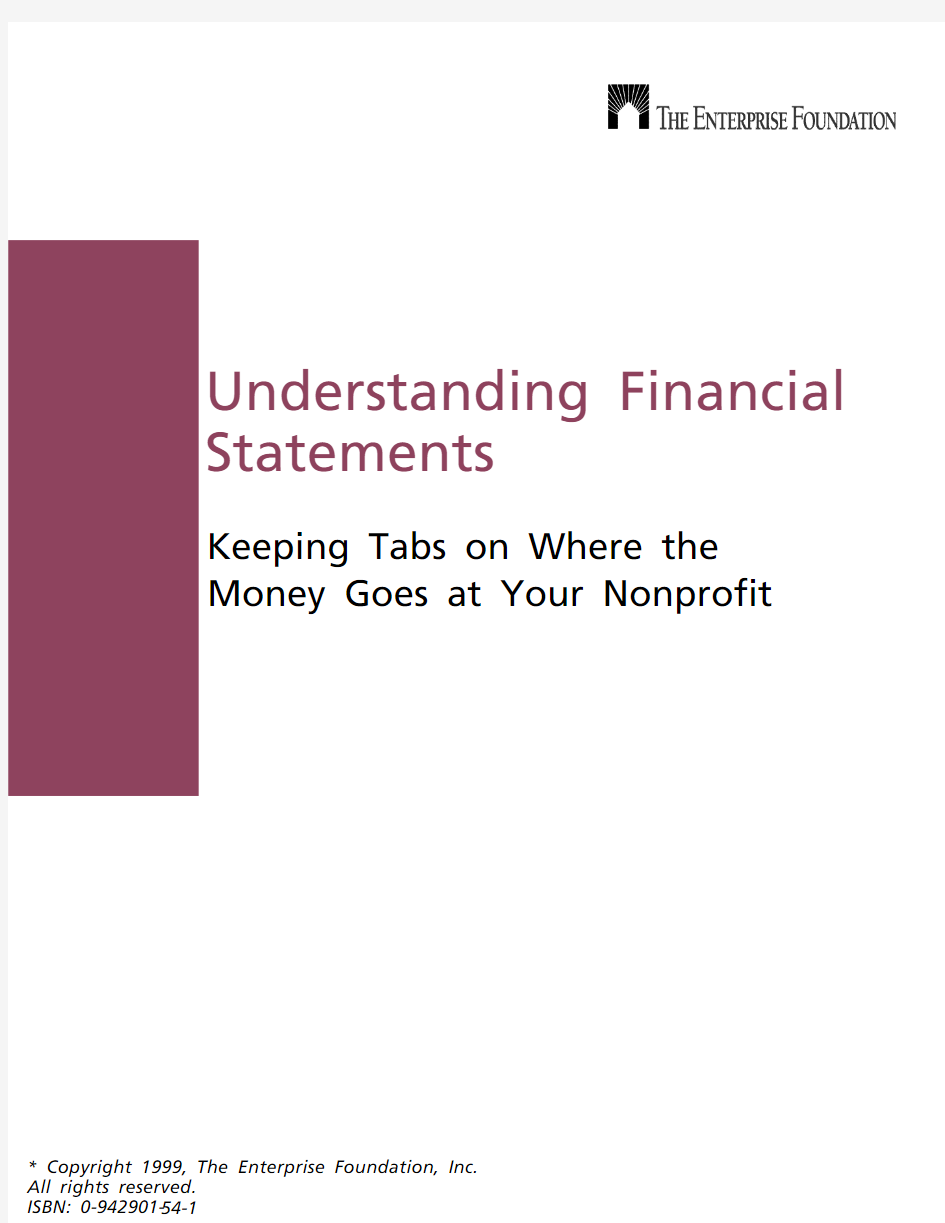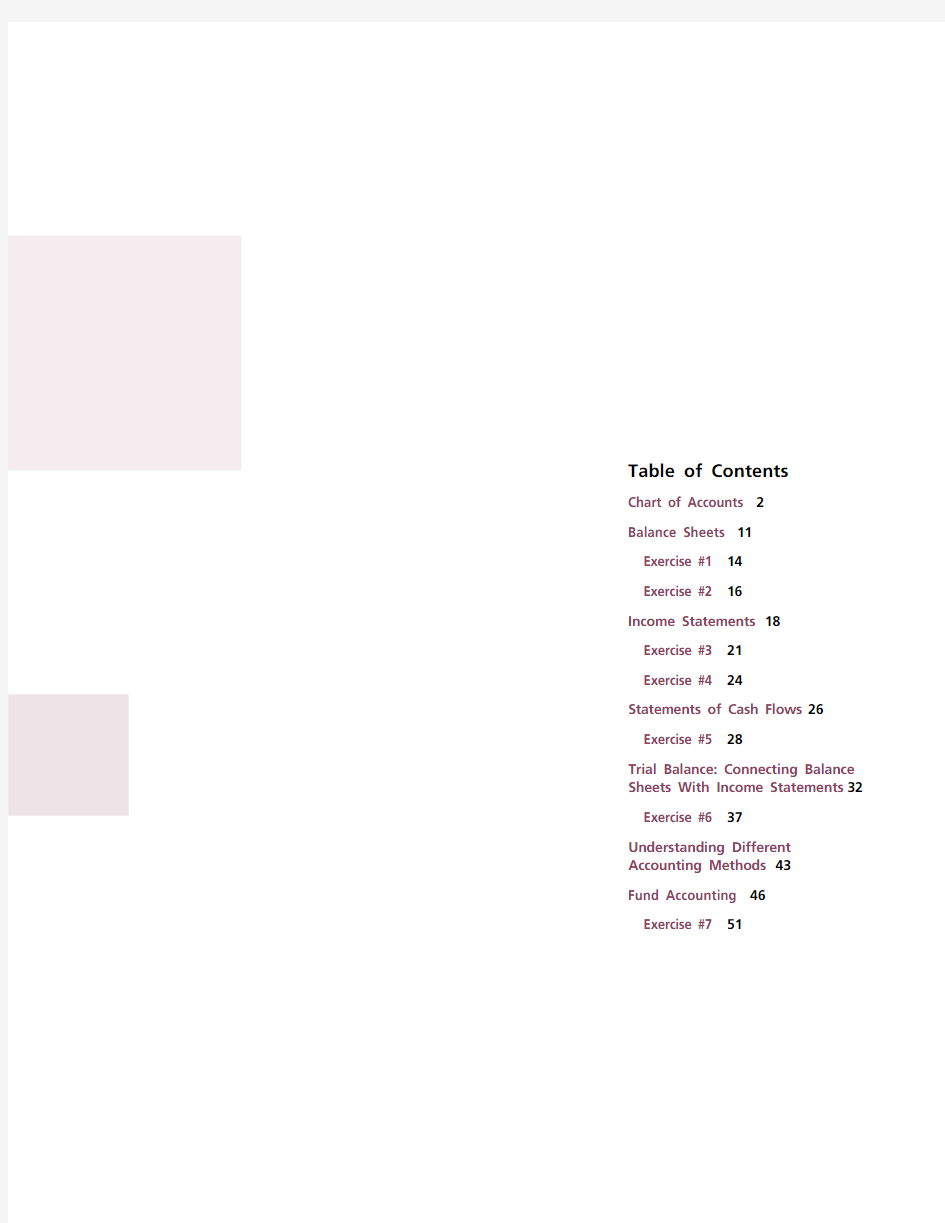

Understanding Financial M O N E Y M A N A G E M E N T
Keeping Tabs on Where the Statements
Money Goes at Your Nonprofit
* Copyright 1999, The Enterprise Foundation, Inc.All rights reserved.ISBN: 0-942901-54-1
Table of Contents
Chart of Accounts 2
Balance Sheets 11
Exercise #1 14
Exercise #2 16
Income Statements 18
Exercise #3 21
Exercise #4 24
Statements of Cash Flows 26
Exercise #5 28
Trial Balance: Connecting Balance Sheets With Income Statements 32 Exercise #6 37
Understanding Different
Accounting Methods 43
Fund Accounting 46
Exercise #7 51
1
Chart of Accounts
The chart of accounts is a listing of the different
accounts used to record the activities or transac-
tions of your organization. A chart of accounts
reflects your nonprofit’s particular nature and
function while using standard accounting terms.
For instance, everyone will have a cash account.
But you may not have an inventory account
unless you are a retailer or wholesaler.
For community development organizations, the
chart of accounts may include accounts related
to single-family development such as construc-
tion in progress.
Five major accounts are used in a chart
of accounts:
s Assets
s Liabilities
s Equity or Net Assets
s Revenues
s Expenses
2
COMMON CLASSIFICATIONS
These five major accounts are larger categories that allow an organization to place its many different
accounts and financial activities into an ordered, comprehensible structure. They help turn a confus-
ing tangle of numbers into a clear narrative about your organization’s financial condition based on
your organization’s particular activities.
3
FOREVER HOMES CDC — CODES & ACCOUNTS
Let’s look at an example of a fictitious 501(c)(3) nonprofit organization, Forever Homes, that has three distinct business operations, all related to housing.
s Managing Pro p e rty Owned by Ot h e r
No n p rofits — In 1998 Fo re ver Homes managed 400 units of affordable multifamily housing.s Developing Single-Family Homes for Sale to First-Time Low-Income Home Buyers —In 1998 Forever Homes developed six houses.
s Providing Supportive Housing for Households with Extensive Social Service Needs —In 1998 Forever Homes owned and managed 15 units of supportive housing.
4
Code Account
1010Cash — Checking
1015Cash — HOME Funds
1020Cash — Savings
1030Cash — Petty Cash
1200Accounts Receivable
1300Prepaid Expenses
1500Land/Buildings
1510Construction in Progress
1520Salable Property
1600Long-Term Investments
1800Office Furniture & Equipment
1801Accumulated Depreciation —
Furniture & Equipment
1900Notes Receivable
2000Accounts Payable
2100Payroll Liabilities
2120Accrued Expenses
2200Purchaser’s Deposits
2300Lease Payable
2400Notes Payable
2500HOME Funds Payable
3000Net Assets
4010Grants (unrestricted)
4011Grants (restricted)
4050Contributions
4100Fund-Raising Event
4150Program Fees
Code Account
4160Training Fees
4170Consulting
4200Sale of Property
4900Interest Income
5000Cost of Property Sold
6010Salaries
6020Benefits
6100Program Supplies
6150Equipment Rental
6200Staff Training
6250Marketing/Advertising
6300Printing & Reproduction
6350Publications & Memberships
6400Travel
7050Fund-Raising & Event Costs
7100Rent
7110Utilities
7120Telephone
7130Insurance
7140Office Supplies
7150Postage & Delivery
7160Repairs & Maintenance
7200Legal Fees
7210Accounting & Auditing Fees
7800Miscellaneous
7900Interest
8000Depreciation
Codes &Accounts
5
6
7
8
Code Account Classification Balance
1010Cash — Checking Current Asset$4,015
1015Cash — HOME Funds Current Asset$34,000
1020Cash — Savings Current Asset$0
1030Cash — Petty Cash Current Asset$250
1200Accounts Receivable Current Asset$1,000
1300Prepaid Expenses Current Asset$450
1500Land/Buildings Housing Inventory$30,000
1510Construction in Progress Housing Inventory$15,000
1520Salable Property Housing Inventory$56,000
1600Long-Term Investments Investment$0
1800Office Furniture & Equipment Fixed Asset$30,000
1801Accum. Depr. — Furn. & Equip.Fixed Asset$13,500
1900Notes Receivable Other Asset$5,000
2000Accounts Payable Current Liability$3,200
2100Payroll Liabilities Current Liability$6,800
2120Accrued Expenses Current Liability$0
2200Purchaser’s Deposits Current Liability$0
2300Lease Payable Long-Term Liability$3,000
2400Notes Payable Long-Term Liability$0
2500HOME Funds Payable Long-Term Liability$135,000
3000Net Assets Net Assets$0
4010Grants (unrestricted)Revenue$75,000
4011Grants (restricted)Revenue$220,000
4050Contributions Revenue$25,000
4100Fund-Raising Event Revenue$5,000
4150Program Fees Revenue$0
4160Training Fees Revenue$21,000
4170Consulting Revenue$20,000
4200Sale of Property Revenue$0
4900Interest Income Revenue$75
5000Cost of Property Sold Cost of Property Sold$0
6010Salaries Direct Expenses$225,000
6020Benefits Direct Expenses$49,500
6100Program Supplies Direct Expenses$0
6150Equipment Rental Direct Expenses$2,000
6200Staff Training Direct Expenses$2,000
6250Marketing/Advertising Direct Expenses$2,000
9
LOOK AT YOUR ORGANIZATION’S
CHART OF ACCOUNTS
Think about what you have just learned and
compare it to the way your nonprofit keeps its
chart of accounts.
Notice the five account classifications:
A s s e t s
L i a b i l i t i e s
Net Assets
Re v e n u e s
Ex p e n s e s
Also look at the level of detail in your accounts:
Forever Homes has one account for salaries.
Does your organization have one or more
than one? Is the classification type listed next
to each account?
1 0
Assumptions
s
Line-item categories are the same as line items in the chart of accounts.s Each consolidated category is broken out into line items.
s The basic accounting equation still holds: Assets = Liabilities + Net Assets
The balance sheet — known officially as a Statement of Financial Position — is a report of the financial position of an organization at one moment in time, providing a snapshot of your company’s financial health. The infor-mation contained in the balance sheet shows your organization’s ability to meet present and future obligations with current resources, how much is owed and how much is owned by the organization.
STANDARD FORMAT
The balance sheet contains the first three of the five major account types:
s
Assets s
Liabilities s
Net Assets
Assets comprise one section of the balance sheet while liabilities and net assets comprise the other section. The “t o t a l s ” of these two sections should balance.
The assets section shows what you own or what resources you have available. The liabilities and net assets section shows what you owe plus the organization’s net account balance.
THE BASIC ACCOUNTING EQUATION Assets – Liabilities = Net Assets
– or –
Assets = Liabilities + Net Assets Again, the balance sheet reflects the financial sta-tus of your organization for one day or moment.A subsequent balance sheet the ve ry next day or moment could show a ve ry different picture. T h e next examples illustrate this concept.
1 1
1 2
Notice:
s The increase in the
Office Furniture & Equipment line item
— from $30,000 in
the December 31 bal-
ance sheet to $32,500
in the January 3 bal-
ance sheet
s C o r r e s p o n d i n g
increases in the
summary line items
Total Fixed Assets
and Total Assets
s The increase in the
liability line item
Accounts Payable
s Corresponding
increases in the sum-
mary line items Total
Current Liabilities,
Total Liabilities, and
Total Liabilities and
Net Assets
1 3
1 4
Answers to Exercise #1
Forever Homes CDC balance sheet — as of Jan. 15, 1999
Bal ance
ASSETS CURRENT ASSETS
Cash — Checking$ 4,015
Cash — HOME Funds1,800
Cash — Savings0
Cash — Petty Cash250
Accounts Receivable1,000
Prepaid Expenses450
Total Current Assets7,515
INVESTMENTS
Land/Buildings62,200
Construction in Progress15,000
Salable Property56,000
Long-Term Investments0
Total I nvestments133,200
FIXED ASSETS
Office Furniture & Equipment32,500
Accum. Depr. — Furn. & Equip.(13,500)
Total Fixed Assets19,000
OTHER ASSETS
Notes Receivable5,000
Total Other Assets5,000
TOTAL ASSETS$ 164,715
LI ABI LI TI ES CURRENT LIABILITIES
Accounts Payable$ 5,700
Payroll Liabilities6,800
Accrued Expenses0
Purchaser’s Deposits0
Total Current Liabilities12,500
LONG-TERM LIABILITIES
Lease Payable3,000
Notes Payable0
HOME Funds Payable135,000
Total Long-Term Liabilities138,000
TOTAL LI ABI LI TI ES150,500
NET ASSETS14,215
TOTAL LI ABI LI TI ES & NET ASSETS$ 164,715
1 5
1 6
1 7
Assumptions
s
Revenues are listed at the top of the page s Expenses are listed below revenues s Net income is listed at the bottom
s Net income = total revenues – total expenses
The income statement — known officially as a Statement of Activity — is a re p o rt that mea-s u res the results of an organization’s activities over a period of time. Ve ry simply, the income statement re p o rts the organization’s re venues and expenses for the given period — month, quart e r,ye a r, etc. — and the resulting difference: pro f i t (surplus) or loss (deficit). The income statement may also be called a statement of re venue and expenses or a profit and loss statement.
STANDARD FORMAT OF
INCOME STATEMENTS
Income statements contain the last two of the five major types of accounts:
s
Revenues s
Expenses
Re venues re p resent re s o u rces flowing into the organization for the period; expenses re p re s e n t uses of those re s o u rces flowing out of the organi-zation. The resulting difference is the net income — profit or loss. In the nonprofit world, it may be more appropriate to refer to net income as
surplus or deficit. You may also see it called the change in net assets.
The standard format of an income statement is simple but can be as detailed as you want, with re v enues and expenses grouped and subtotaled into subtypes or classifications. W h e r eas the balance sheet shows the financial position of the organization for the re p o r t date, the income statement shows the financial performance of the organization for the re p o r ting period.
REVENUES LESS EXPENSES EQUALS NET INCOME
An income statement may not necessarily report on all incoming resources and outgoing uses.For example, a bank loan coming into the orga-nization and the payments of principal going out will not be reflected (although interest owed and paid on that loan will be reflected in the income statement). (See the Statement of Cash Flow section for more information.)
1 8
Assumptions
s Line-item categories are the same as the line items in the Chart of Accounts
s Each consolidated category is broken out into line items
s Net income = total revenues – total expenses
1 9